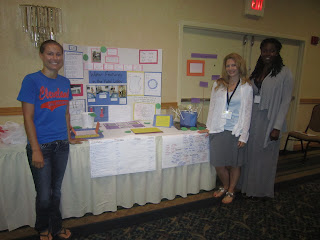I realize as I reread my earlier posts that there is so much more detail to this work that I am not writing about; the importance of and methods of engaging children in the question process, how to divide children into interest groups for field work, observational drawings, and so on. If I covered it all it would be a book, not a blog post. I am choosing the areas that I have chosen to reflect on the most. However, I am excited to share this with other educators that are interested, to experiment with it and refine it in my own classroom and continue to learn more as I engage with other colleagues. I am hoping to share more of this as I post actual project work that will be done with my students as we begin our school year in just a few weeks.
That said I am particularly proud of my hot tub, so I am going to share some of my Phase 3 experience.
Sharing what has been learned with others enriches the process. Knowledge can be shared in an infinite number of ways and the beauty of this type of work is that children are given choices. Throughout the process so much choice is embedded bringing ownership to the learner. Some of the ways to share findings are drawings, paintings, clay sculptures, rubbings, poems, stories, time lines, Venn diagrams, survey results, models, photographs displays, collage and so many more. Inviting parents or other classes to see a display of their project work is rewarding and gives children a chance to be the experts and feel the fruit of their hard work.
The final display is really the story of the process of the learning. It will include the topic webs, Phase I writings and drawings, field sketches (Phase 2 work), photographs with captions and a variety of representations of the findings such as those mentioned above. It should tell the story of the process and the learning that occurred along the way.
In our group we had to negotiate with each other what we were going to display. We didn’t display all the memory drawings, we chose one. One person made a graph, another did a drawing and another created an experiment for people to try. All of the work of each person was not displayed. Choices are made. With this approach it needs to be explained that the display portion is not about showing off everything that each person has done, but about using pieces of each person’s work to tell the story of the learning. As a teacher I think it is very easy to get caught up in feeling that you need to always display something from each child. This is what often leads to 16 school bus drawings lined up in a row. This will need parent education as well. Parents become very accepting when you are able to explain your reasoning and the process to them.
I became very interested, okay obsessed, with making a working model of the hot tub. I “borrowed” the ice bucket liner from my hotel room and gathered straws to create the jets. My first attempt failed miserably sending water all over the conference room.
But then, my team members offered suggestions and encouragement and praise and I kept going. Again, this is what I want in my classroom, this sense of community and problem solving and helping one another. By the time we shared our display, I had a working model of the hot tub, complete with bubbles!
Our group shared our findings and our process with the rest of the attendees answering questions and engaging them in our experiments. It is irrelevant that I now know how to test the PH of a pool, or the correct temperature of a hot tub, or that yes, they do enforce the rules and you should not be drinking a glass of wine in the hot tub…we were proud of our work and excited by the process. We formed connections with each other and supported each other in the shared content of our project. We felt the joy of learning. This is what I want to give my students.
My water feature group with Sylvia Chard and Lillian Katz







